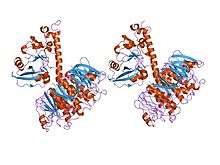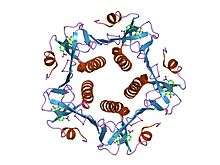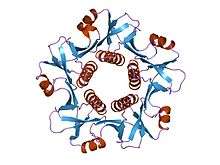Heat-labile enterotoxin family
In molecular biology, the heat-labile enterotoxin family includes Escherichia coli heat-labile enterotoxin (Elt or LT) and cholera toxin (Ctx) secreted by Vibrio cholerae.
| Heat-labile enterotoxin alpha chain | |||||||||
|---|---|---|---|---|---|---|---|---|---|
 cholera holotoxin, crystal form 1 | |||||||||
| Identifiers | |||||||||
| Symbol | Enterotoxin_a | ||||||||
| Pfam | PF01375 | ||||||||
| Pfam clan | CL0084 | ||||||||
| InterPro | IPR001144 | ||||||||
| SCOPe | 1lts / SUPFAM | ||||||||
| |||||||||
| Heat-labile enterotoxin beta chain | |||||||||
|---|---|---|---|---|---|---|---|---|---|
 cholera toxin b-pentamer complexed with metanitrophenyl-alpha-d-galactose | |||||||||
| Identifiers | |||||||||
| Symbol | Enterotoxin_b | ||||||||
| Pfam | PF01376 | ||||||||
| InterPro | IPR001835 | ||||||||
| SCOPe | 1lts / SUPFAM | ||||||||
| |||||||||
| Type II heat-labile enterotoxin , B subunit (LT-IIB) | |||||||||
|---|---|---|---|---|---|---|---|---|---|
 escherichia coli heat labile enterotoxin type iib b-pentamer | |||||||||
| Identifiers | |||||||||
| Symbol | LT-IIB | ||||||||
| Pfam | PF06453 | ||||||||
| InterPro | IPR010503 | ||||||||
| SCOPe | 1tii / SUPFAM | ||||||||
| |||||||||
lt is so named because it is inactivated at high temperatures.[1]
Mechanism
The A subunit are transported inside by the pentameric B subunits. It then acts by raising cAMP levels through ADP-ribosylation of the alpha-subunit of a Gs protein leading to the constitutive activation of adenylate cyclase. Elevated cAMP levels stimulate the activation of the CFTR channel thus stimulating secretion of chloride ions and water from the enterocyte into the gut lumen. This ionic imbalance causes watery diarrhea.
In addition to its effects on chloride secretion, which involve the same steps as the effects of cholera toxin, Elt binds additional substrates: lipopolysaccharide on the surface of E. coli cells and A-type blood antigens.[2] The importance of these binding events is not yet known.
Structure
These toxins consist of an AB5 multimer structure, in which a pentamer of B chains has a membrane-binding function and an A chain is needed for enzymatic activity.[3] The B subunits are arranged as a doughnut-shaped pentamer, each subunit participating in ~30 hydrogen bonds and 6 salt bridges with its two neighbours.[3]
The A subunit has a less well-defined secondary structure. It predominantly interacts with the pentamer via the C-terminal A2 fragment, which runs through the charged central pore of the B subunits. A putative catalytic residue in the A1 fragment (Glu112) lies close to a hydrophobic region, which packs two loops together. It is thought that this region might be important for catalysis and membrane translocation.[3]
The structural arrangement of E. coli type I and type II heat-labile enterotoxins are very similar, although they are antigenically distinct.[4]
Origin
The cholera toxin is carried by the CTXφ bacteriophage and may be isolated from plamids. The E. coli LT (elt) is similarly associated with mobile elements, in this case Ent plasmids that can carry LT, ST, or both. Partial insertion sequences (ISs) flanking the elt genes provide extra transmission capabilities by homologous recombination at their inverted repeats.[5] Οβ phage-induced conversion in E. coli has been described as well.[6]
Applications
The B subunits of toxins in this family is relatively harmless on its own. CtxB is routinely used as a neuronal tracer.[7] Elt-IB has been looked into as an adjuvant in trandermal vaccines.[8][1]
References
- Glenn GM, Flyer DC, Ellingsworth LR, et al. (October 2007). "Transcutaneous immunization with heat-labile enterotoxin: development of a needle-free vaccine patch". Expert Rev Vaccines. 6 (5): 809–19. doi:10.1586/14760584.6.5.809. PMID 17931160.
- Mudrak B and Kuehn MJ (2010). "Heat-labile enterotoxin: Beyond GM1 binding". Toxins. 2 (6): 1445–1470. doi:10.3390/toxins2061445. PMC 3153253. PMID 22069646.
- Sixma TK, Kalk KH, van Zanten BA, Dauter Z, Kingma J, Witholt B, Hol WG (April 1993). "Refined structure of Escherichia coli heat-labile enterotoxin, a close relative of cholera toxin". J. Mol. Biol. 230 (3): 890–918. doi:10.1006/jmbi.1993.1209. PMID 8478941.
- van den Akker F, Sarfaty S, Twiddy EM, Connell TD, Holmes RK, Hol WG (June 1996). "Crystal structure of a new heat-labile enterotoxin, LT-IIb". Structure. 4 (6): 665–78. doi:10.1016/s0969-2126(96)00073-1. PMID 8805549.
- Schlor, S.; Riedl, S.; Bla, J.; Reidl, J. (1 January 2000). "Genetic Rearrangements of the Regions Adjacent to Genes Encoding Heat-Labile Enterotoxins (eltAB) of Enterotoxigenic Escherichia coli Strains". Applied and Environmental Microbiology. 66 (1): 352–358. doi:10.1128/AEM.66.1.352-358.2000. PMC 91829.
- Takeda, Y; Murphy, JR (January 1978). "Bacteriophage conversion of heat-labile enterotoxin in Escherichia coli". Journal of Bacteriology. 133 (1): 172–7. PMC 221991. PMID 338578.
- Pierre-Hervé Luppi. "The Discovery of Cholera-Toxin as a Powerful Neuroanatomical Tool". Retrieved 2011-03-23.
- Wagner B, Hufnagl K, Radauer C, et al. (April 2004). "Expression of the B subunit of the heat-labile enterotoxin of Escherichia coli in tobacco mosaic virus-infected Nicotiana benthamiana plants and its characterization as mucosal immunogen and adjuvant". Journal of Immunological Methods. 287 (1–2): 203–15. doi:10.1016/j.jim.2004.02.001. PMID 15099768.